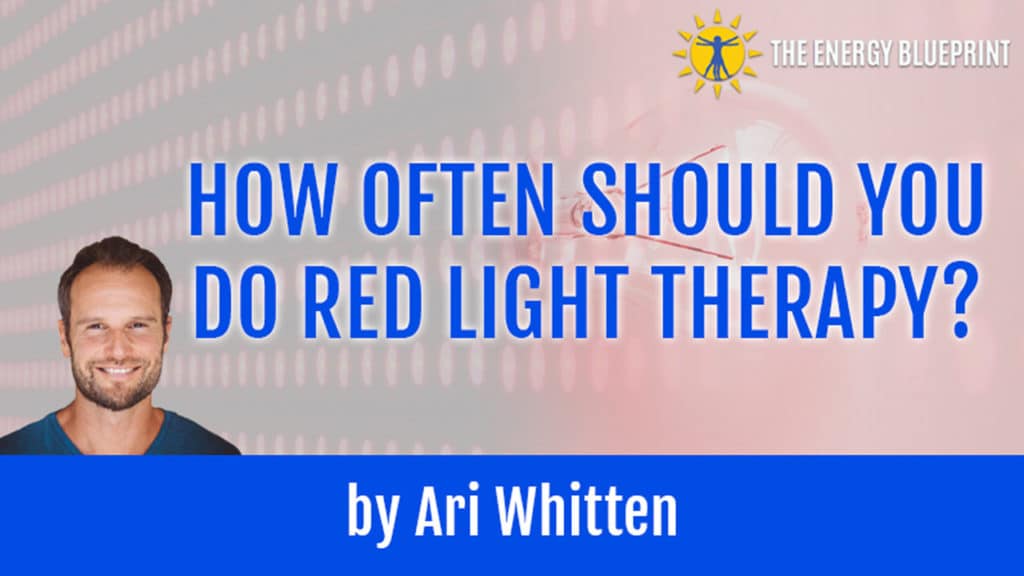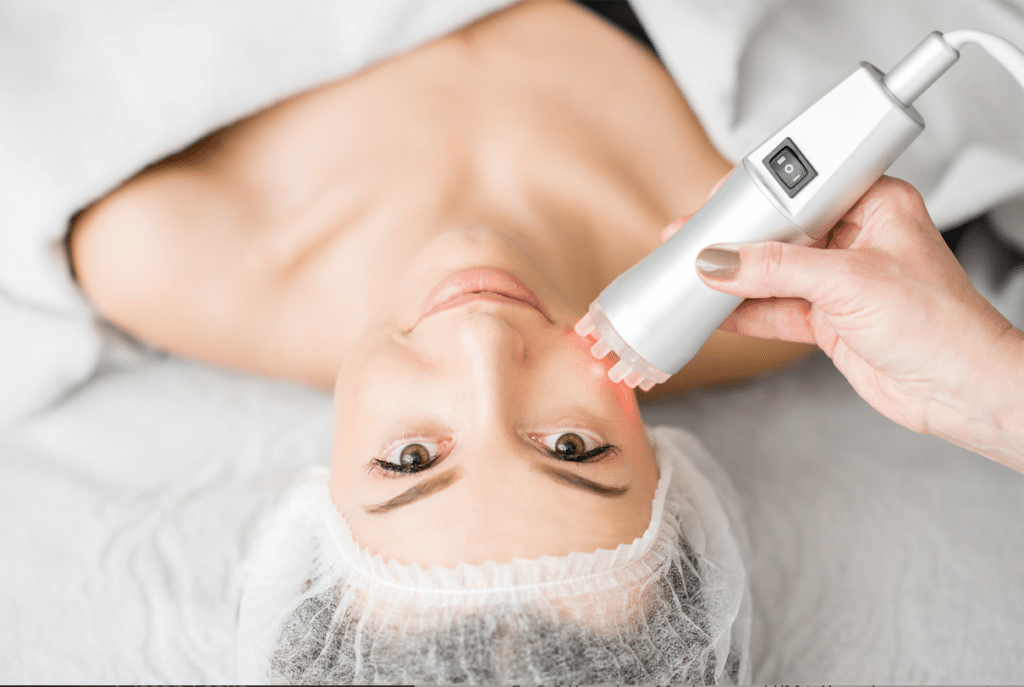Red-light therapy is an amazing treatment promising help with everything from weight loss to eczema. Developed by NASA in the 1990s to help grow plants in space, it was only available as a therapeutic treatment in clinical settings until recently. Now its specialized lamps can be purchased for home use at a fraction of the cost.
We absorb red and near-infrared light all the time, of course—it’s a mostly invisible part of the light spectrum. But the sun doesn’t deliver the right wavelengths in nanometers of light or the intensity necessary for therapeutic results. Red-light therapy lamps dial it up to 11, so to speak, so the light is able to penetrate deep within the body and do its good at the cellular level. Using low-light laser treatments or light-emitting diodes (LED lights), you might also see red-light therapy (or RLT) referred to as:
- Photobiomodulation (PBM)
- LED light therapy
- Low-level light therapy (LLLT)
- Soft laser therapy
- Cold laser therapy
- Biostimulation
- Phototonic stimulation
- Low-power laser therapy (LPLT)
Whatever the name it goes by, however, RLT carries no skin-cancer or other health risk like basking outside in the sun’s UV rays does. Rather it offers real hope for people dealing with a variety of chronic health problems—as long as they use it at the right strength and frequency.
Red-light therapy benefits
RLT is natural, noninvasive and free of side effects. The FDA has approved several red-light therapy devices. And clinical studies have demonstrated its ability to help people with many stubborn problems:
- Brain health
Red-light therapy works to preserve and renew brain cells and tissues and stimulate the mitochondria—part of the cell associated with energy.1 High-quality therapeutic devices can penetrate the skull to increase cerebral blood flow and oxygen consumption. There is also evidence light therapy treatments can help brain disorders and injuries 2
- Acne
RLT can clear up acne by increasing lymphatic drainage, which clears the body of toxins. With the American Academy of Dermatology calling acne “the most common skin condition in the United States,” that’s a lot of potential people helped by this noninvasive treatment.3 Other skin conditions like eczema and rosacea can also benefit, making it a great option for many skin types.
- Skin tightening
Speaking of skin, RLT is a totally noninvasive anti-aging method of skin rejuvenation, making it look plumper, firmer, less prone to sun damage—and more youthful—by stimulating elastin and collagen production. With no side effects, you won’t face the hours or days of redness, bruising or tenderness other anti-aging treatments like Botox, fillers, or other treatments you may get at the dermatology clinic.
- Hair loss and growth
What you may have resigned yourself to see as permanent states may be addressed by this benign therapy, which encourages hair growth.
- Cellulite
RLT has been shown to whittle away body circumference, effectively contouring and toning the body. By increasing circulation and heightening the effects of exercise—and especially when combined with massage—users of red-light therapies can watch their cellulite and stretch marks disappear and their skin tone improve.
- Wound healing
Red-light therapies have proven effective in speeding up healing after injuries by cleaning away dead skin cells and promoting new growth.
- Fibromyalgia, chronic fatigue and lack of energy
RLT addresses the pain associated with chronic fatigue conditions like fibromyalgia and boosts energy in general.4
- Hashimoto’s Hypothyroidism
When your thyroid gland doesn’t produce enough hormone, all kinds of bodily functions slow down. Red-light therapy can speed it back up—to the point of sufferers no longer needing their medication for pain relief and the alleviation of other symptoms.
- Bone healing
RLT stimulates the production of energy in bone cells, meaning faster recovery from painful injuries.
- Inflammation and potential inflammation-related diseases
Red-light therapy reduces oxidative stress, a kind of cell damage that leads to an inability of the cell to function properly, which in turn leads to chronic problems like inflammation. Inflammation is the body trying to heal itself after an injury, respond to an illness, or expel something irritating to its normal functioning. People experience it as everything from mouth sores to fatigue to joint pain.
- Eye health
Studies have shown RLT to improve the vision of people with a variety of eye problems, like macular degeneration. But note that red-light therapy should be undergone using eye protection.
- Anxiety and depression
A very encouraging test of red-light therapy use in patients with anxiety and depression found a reduction in their symptoms.
- Cognitive performance
Another study found people’s attention span and memory improved after undergoing red-light therapy. 5
- Tendonitis
Tendonitis is another painful, chronic condition that benefits from red-light therapy’s ability to decrease inflammation, increase production of collagen and aid wound healing.
- Fertility
A very promising study in Denmark found RLT increase pregnancy rates among couples who had previously struggled. Infertility is an issue affecting up to 10% of American women.6
- Arthritis and joint health
Multiple scientific studies have demonstrated red-light therapy’s ability to decrease pain in joints and increase their range of motion.
- Diabetes symptoms
RLT can increase circulation, assist healing and offer other benefits to diabetics dealing with the many side effects of that disease.
- Oral health
Mouth pain, cold sores, periodontal disease, thrush–even soreness associated with braces. RLT addresses a host of oral-health issues.
- Respiratory health
It has also proven an effective tool for people suffering from chronic respiratory illnesses like asthma and COPD.
- Pain relief
Neck, back, knee, and other joint pain can really affect a person’s daily quality of life. Red-light therapies have provided relief to people struggling with pain experienced for varying reasons throughout the body.
- Traumatic brain and spinal-cord injury
As the medical community learns more and more about traumatic brain injury, red-light therapies offer improved brain function, better muscle recovery and other benefits to those who have experienced it. RLT also can help those with spinal-cord injuries.
- Improved sleep
Up to 70 million Americans struggle with problems sleeping.7 And that doesn’t just make for groggy mornings—lack of proper sleep can lead to serious health issues like heart disease. The blue light emitted from our electronic devices, which we all love staring at in bed at night, can be blamed for waking our brains up rather than helping shut them down at bedtime. But using red light in the evening, rather than that disruptive blue light, can ease people back into healthy rest patterns.
- Muscle strength, endurance, and recovery
By affecting the mitochondria and, to oversimplify, the cell’s ability to produce energy, RLT is the athlete’s dream, increasing their ability to push their bodies to greater physical heights.
- Weight loss
RLT won’t solve your weight problem alone—healthy diet and exercise will always be necessary—but it can boost your efforts considerably by attacking fat stores and shaving inches off your measurements. With almost 40% of Americans classified as obese, red-light therapies offer a potentially revolutionary tool to address this public-health crisis.8
- And more
How does RLT work?
Just how does it achieve these disparate results? Red-light therapies use red and near-infrared light because it’s “bioactive” in humans. It affects our cells. And it does so at a deeper level than other kinds of light and in a healing way.
Basically, special lamps deliver safe, concentrated wavelengths of therapeutic natural light to your skin and cells, where it reduces oxidative stress and stimulates cellular energy production (adenosine triphosphate or ATP). This in turn helps improve cell functioning.
But like other therapies, the concentration and frequency of use affect the outcome.
Where to get red-light therapy
Once only available in (expensive) clinical settings, it’s now possible to get red-light therapies at gyms, spas, tanning salons, and other places. However, there are many red-light therapy devices or red LED lights—some FDA approved—now on the market for home use.9
These can range from large red-light therapy beds or light beds that resemble tanning beds for full-body therapy to small hand-held wands for concentrated efforts. For the cost of just one or two visits to a dermatologist clinic, you can have unlimited sessions in your own space and on your own time.
But there are a few things to consider when choosing a machine:
- What’s your goal? Different machines work best for different purposes. For some conditions, a visit to a professional is still advisable.
- How powerful is the machine? This is very important. You must make sure the light will be within the therapeutic range—and many are not. A machine without the ability to emit the right kind and intensity of light will only waste your money.
- How large is it? A large enough lamp will be self-supporting, meaning you can do other things at the same time, and cover more areas of the body. Again, it depends what your goals are.
In general, larger machines will probably prove more practical than smaller ones, as they take in more of the body and require less participation on your part, so you may find sessions more convenient.
But either way, with a little care, you may end up with the same machine being used at a much-more-expensive clinic—except in the privacy of your own home and available whenever you feel like it.
OK, now how often and how much?
With the right light therapy product in hand, it’s time to figure out how often to use it.
A recent study examining red-light therapy’s effect on fine lines, wrinkles, and skin texture found twice-a-week sessions for a total of 30 minutes achieved positive results with which patients were satisfied.10
Red-light therapy is proven safe, without any negative effects, and there is no downtime after treatments. For starters, it is best to commit to three to five sessions a week for the first one to four weeks and then two to three times a week for the next four to 12 weeks. But it is safe to use more than once per day.
As for the duration of each session, it depends on the effects you’re trying to achieve, but you should pay attention to the joules (or energy units), not the clock. For example, a session seeking brain benefits requires a few thousand joules, so if your device only emits a few hundred you might be out of luck.
How long do I stick with it?
You could see a healthier glow after a single session—in as little as 20 minutes!—but don’t stop just when you start to see results. Expect to stick with your regimen for eight to 12 weeks to see full effects. Then it’s best to undergo weekly maintenance of one to two sessions per week.
Because RLT is safe, with no side-effects, you don’t have to worry about overdoing it. You will not hurt your skin, for example, by accidentally using red-light therapies more than you may have been recommended.11
But as with any health regimen, it’s best to do your research and come up with a plan based on facts and/or the advice of a qualified professional.
Red-light therapy is for everyone
Again, red-light treatment promises help in many areas, from energy depletion to hair loss, and it has very little downside. If you’re intrigued, your next stop may be online to check out the myriad of devices available. In that case, this blog post outlines my recommendations for the most effective and affordable options and answers other faqs.
References[+]






